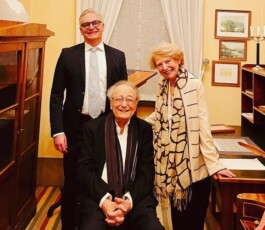


Novembre 11, 2022
Each week, discover one of the members of the Network of Houses and Museums of European Musicians. These places link the past, present and future, they honor a tangible and intangible heritage and fulfill an essential cultural purpose in Europe. This week, we invite you to Leipzig in the German state of Saxony to discover the magnificent and unique house-museum dedicated to the great Romantic composer Felix Mendelssohn-Bartholdy (1809-1847).

Felix Mendelssohn was the grandson of the philosopher and rabbi Moses Mendelssohn, one of the main instigators of the Haskalah, the Jewish Enlightenment movement. This movement advocated emancipation for Jews and a move away from communitarianism. The composer became an embodiment of this movement, emancipating himself as a major composer of the Romantic movement in Germany. He was the son of the banker and philanthropist Abraham Mendelssohn Bartholdy and the brother of the composer Fanny Mendelssohn.

The German composer, conductor and pianist has left a rich musical legacy, including no more than 750 compositions. And this despite his premature death at 38 in 1847. Felix Mendelssohn became emancipated through his travels throughout Europe and composed some of the most beautiful pieces of music of the Romantic period: A Midsummer Night's Dream, Romances without Words and the Violin Concerto No. 2 in E minor.
Mendelssohn: "A Midsummer Night's Dream" conducted by Daniele Gatti - with Lucy Crowe
During his many journeys, this protégé of Johann Goethe kept up an important correspondence, and like Pauline Viardot, he enhanced his letters with drawings, his other passion: "I want to draw every day, in order to take with me sketches of the places I wish to remember," he wrote in Mendelssohn's Unpublished Letters, translated by Abraham-Auguste Rolland, Letter XXIII, Rome, 1 March 1831.
The famous composer Felix Mendelssohn-Bartholdy (1809-1847) settled in Leipzig and became director of the Leipzig concert house, the Gewandhaus. He spent the last two years of his life in this house, where he died. It became a museum 150 years after his death, in 1997. The Felix Mendelssohn Bartholdy School of Music and Drama was also founded in Leipzig in 1843. It was the first major German musical institution.

The Mendelssohn-Haus was built in 1844
This beautiful classical building, built in 1844, is the only place in the world connected with Mendelssohn's life that is virtually intact. The composer lived here with his family on the first floor. Visitors to the magnificent museum can learn about the composer's life and work through exhibitions and objects. A total of about 700 square metres of exhibition space in the main building and about 200 square metres in the garden pavilion provide visitors with information about the life and work of the musician and composer. Numerous manuscripts, scores, rich correspondence and watercolours by the great Romantic musician are on display.

The music room of the Mendelssohn-Haus frequented by Berlioz, Schumann and Wagner - Photo credits - Website Mendelssohn-Haus
Other historical interests include the exhibition of the period furniture, the reconstruction of the music room, which was frequented by Berlioz, Schumann and Wagner at the time, and Mendelssohn's study, which has also been restored to its original condition. High quality lectures and concerts are regularly held here, especially in the music room. The great pianist Alfred Brendel (photo below), an early supporter of the Centre Européen de Musique, recently gave a lecture on the theme of Goethe and music "Naïveté and Irony - Goethe's Musical Needs".

Another key aspect of the Mendelssohn-Haus is its intergenerational aspect. Indeed, the museum offers many activities for children. An event on "Mendelssohn's World for Children" is held on the first Sunday of every month. Small events are held regularly in the garden pavilion during the summer holidays. A great way to pass on this rich heritage to the youngest visitors.
More information on the website of the Mendelssohn Haus


Playlist